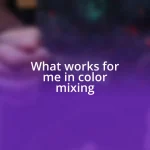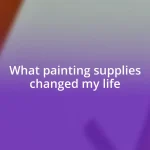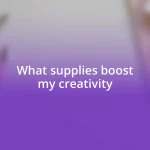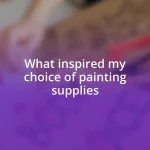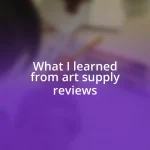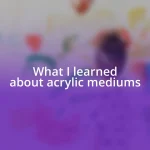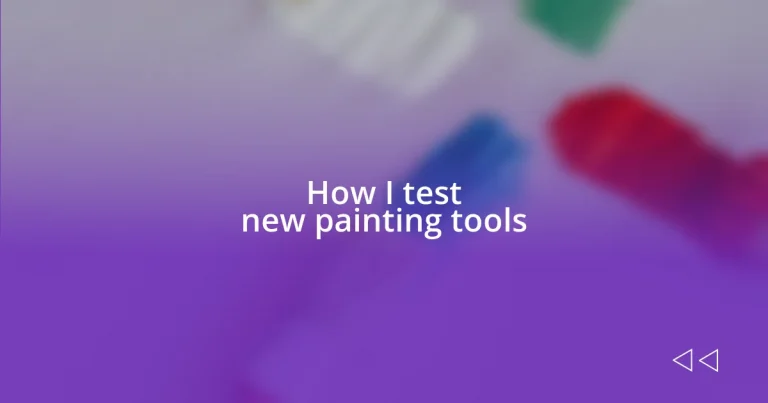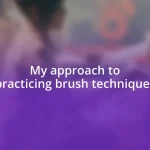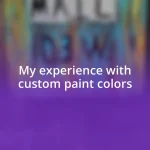Key takeaways:
- Choosing appropriate painting tools enhances the painting experience and is influenced by factors like medium, comfort, and functionality.
- Setting up a well-organized and comfortable workspace, with adequate lighting and ambiance, fosters creativity and productivity during painting sessions.
- Documenting tool performance and experiences aids in making informed decisions about which tools support creativity and efficiency in artistic processes.
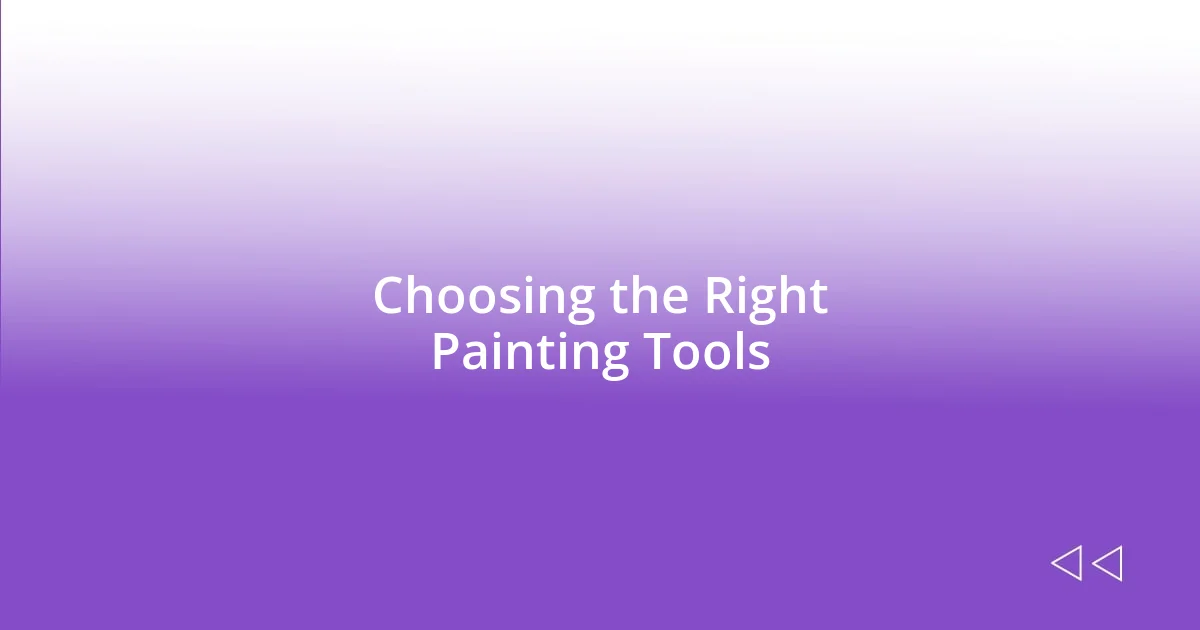
Choosing the Right Painting Tools
Choosing the right painting tools can truly make or break your artwork. I remember when I first ventured into oil painting; I was overwhelmed by the sheer variety of brushes available. Each brush felt like a different voice, waiting to express something unique on the canvas. How do you decide which one to pick?
It’s essential to consider the medium you’ll be using. For example, acrylic paint dries quickly, so a synthetic brush can be advantageous. I once used a natural bristle brush with acrylics, and let me tell you, it felt like running a marathon in flip-flops—a bit tough on the flow! Have you thought about how the tool will interact with the paint?
The comfort of the handle matters too. I had a set of brushes once that looked beautiful but felt awkward in my hand. Each stroke was a struggle, which was frustrating. What about you? Do you prioritize aesthetics, or does functionality rule your toolbox? Remember, the right tools can transform not just your process, but your entire painting experience.

Preparing Your Workspace for Testing
Preparing your workspace is a vital step that I never overlook when testing new painting tools. I remember a time when I joyfully set up in a cozy corner of my living room, only to discover later that poor lighting led to a lackluster finish. Now, I always ensure that my workstation is equipped with adequate lighting, a clean surface, and easy access to my color palette. Have you evaluated how the layout affects your creative flow?
Creating a comfortable environment is crucial. I like to keep my tools organized, so I can focus on the painting and not distract myself with searching for supplies. A clutter-free zone allows my mind to stay present, making the testing process feel almost meditative. Do you find certain organizational methods help streamline your creative process?
Lastly, I personally enjoy playing some ambient music in the background when I work. It sets a tone and can even influence my strokes and choices. I’ve noticed that the right atmosphere can spark creativity; the other day, a mellow playlist transformed my feelings, leading me to experiment with colors I usually wouldn’t choose. What have you found that lights the spark for your creativity?
| Aspect | Considerations |
|---|---|
| Lighting | Ensure adequate natural or artificial light to see true colors. |
| Surface | Choose a flat, clean workspace to prevent distractions. |
| Organization | Keep tools accessible and tidy for a smoother testing process. |
| Ambiance | Play music or create a serene atmosphere to encourage creativity. |

Evaluating Tool Performance Factors
When I evaluate painting tools, I focus on several performance factors that significantly impact my experience. For instance, I remember testing a brand of brushes that promised fine detail but failed to hold the paint well. It was like trying to write with a pen that had run out of ink—frustrating and uninspiring. The brush bristles barely held together, and I ended up spending more time correcting mistakes than enjoying the painting process. To avoid such disappointments, I closely examine these performance factors:
- Paint Retention: How well does the tool hold the paint? I prefer tools that don’t require constant dipping.
- Stroke Consistency: Does the brush deliver even strokes, or is it erratic? A smooth application makes all the difference.
- Durability: Will this tool withstand regular use? I’ve learned the hard way that cheaper materials don’t last, often affecting the quality of my work.
- Ease of Cleaning: How quickly can I clean the tool after use? Tools that are easy to maintain leave me more time to create.
In my experience, the weight and balance of a tool also play a crucial role, although it can be subtle at first. I recall a time I picked up a palette knife that felt almost too heavy in my hand; I struggled to manipulate it the way I wanted. It was an eye-opener—I realized that the right weight can enhance control and impact the quality of my strokes. Here’s what I consider when assessing weight and balance:
- Grip Comfort: Does the handle fit comfortably in my hand? A good grip enables longer painting sessions.
- Control: How does the weight impact my control? A well-balanced tool feels like an extension of my creative flow.
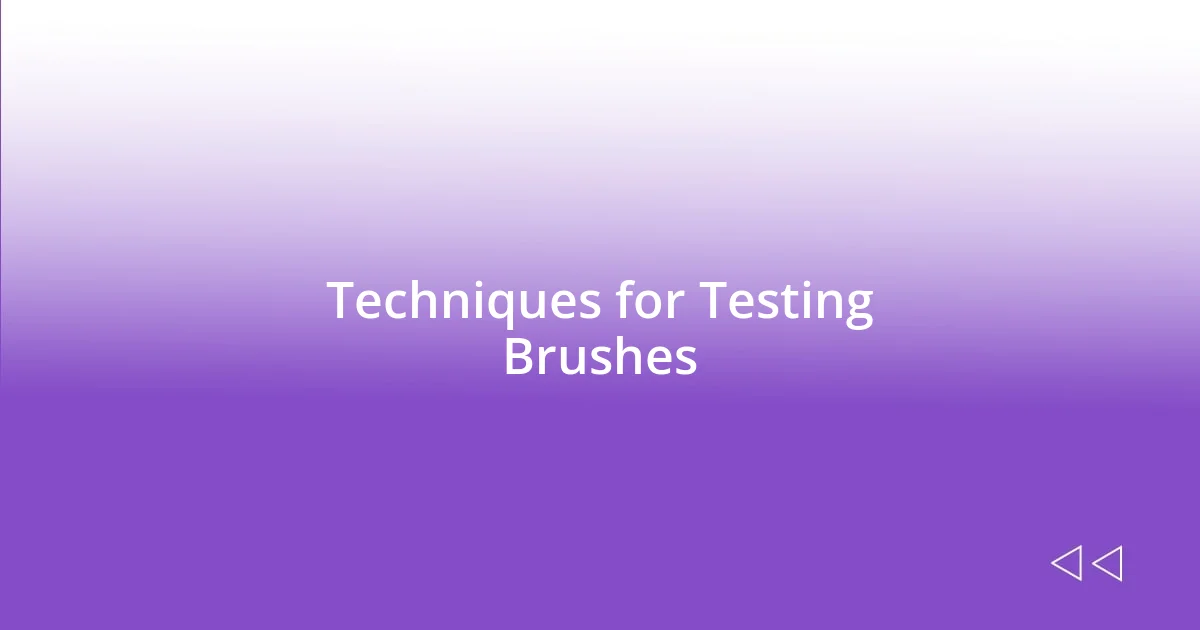
Techniques for Testing Brushes
When testing new brushes, I often begin with a canvas full of different brush strokes. It’s fascinating to see how each brush reacts with various paints and mediums; I remember one time using a fan brush that transformed a flat area into a luscious landscape just by varying my pressure. Have you ever felt that a particular brush could take your artwork in a whole new direction?
I also like to pay attention to the brush’s response to different techniques. For example, while creating fine lines, I noticed that a round brush performed beautifully, allowing for delicate details, whereas a flat brush struggled, leaving harsh edges. It’s like conversing with the tool; the better I understand its strengths, the more I can adapt my technique. How do you gauge a brush’s versatility during your creative process?
Lastly, I find it essential to evaluate how a brush feels over time. There was a moment when I used a brush for an extended period, and by the end, my hand felt fatigued—definitely not ideal for long sessions! A comfortable grip can make all the difference. Have you experienced the joy of a brush that feels like a natural extension of your hand, allowing you to paint for hours without discomfort?
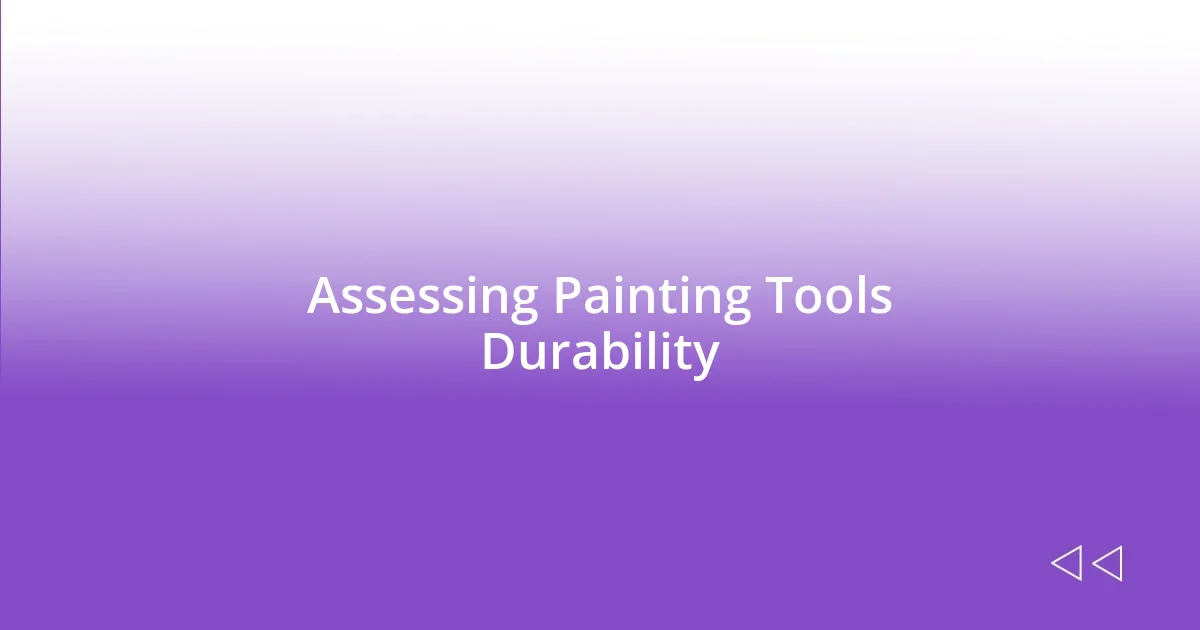
Assessing Painting Tools Durability
When it comes to assessing the durability of painting tools, I often remind myself of a particular set of acrylic paintbrushes I invested in a few years back. Initially, they felt robust and well-made. However, after a week of heavy use, the bristles started to fray, and I could feel my frustration bubbling up. Has that ever happened to you? Tools that deteriorate quickly can throw off my creative flow and make me question my choices.
I always put tools through a rigorous test to check their resilience. One time, I decided to see how a roller held up after painting two large walls. To my surprise, the foam roller began to break apart, leaving bits in my paint job. That experience taught me the importance of not just examining a tool’s appearance but actively using it under realistic conditions. Can you really trust a tool unless it has weathered the storm of an actual project?
Another aspect that stands out to me is the material used in the tool’s construction. I recall buying a palette knife made of metal instead of plastic, and I could feel the difference immediately—sturdy and reliable. It was a breath of fresh air! The right material usually translates to longevity and consistent performance. How often do we overlook these details, only to regret it later when something snaps or bends? I’ve learned to prioritize durability in each tool I test, allowing me to focus on my art without the constant worry of tool failure.
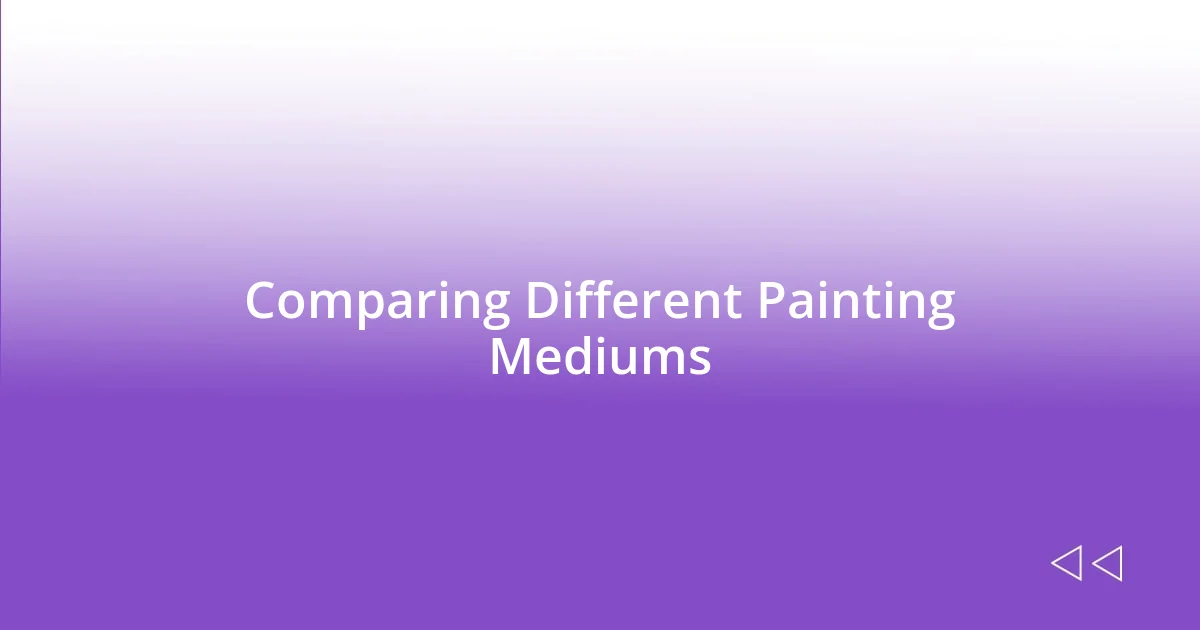
Comparing Different Painting Mediums
When I dive into the world of painting mediums, I can’t help but feel a mix of excitement and curiosity. Each medium has its own personality, from the fluid nature of watercolors to the rich textures of oils. I vividly remember the first time I transitioned from acrylics to oils; it was like switching from a fast-paced song to a slow, soulful melody. Have you ever experienced that moment of discovering a new medium that just clicked with your artistic sensibilities?
As I explore the interplay between different mediums, I often find that they evoke distinct emotions and techniques. For instance, working with gouache is somewhat of a dance—a back-and-forth play between transparency and opacity. I recall a project where I combined gouache with ink, creating an entirely new visual narrative. It’s fascinating how the right medium can shape an artwork’s story. What mediums have you experimented with that expanded your creative horizons?
In my experience, the choice of medium can dramatically influence the final outcome of a piece. I remember once using a heavy-bodied acrylic on a textured canvas; the depth and vibrancy were absolutely mesmerizing. This discovery urged me to revisit simpler techniques that I had overlooked before. Have you noticed how the feeling of a brush on a particular medium can inspire your next brush stroke? Each choice feels like unlocking a new door to creativity, and it’s something I cherish every time I approach my workspace.

Documenting Your Testing Results
I’ve found that thoughtfully documenting my testing results is crucial for tracking my experiences with different painting tools. I often jot down notes immediately after each session—things like how the brush felt in my hand, the texture of the paint application, and any quirks that stood out. It’s amazing how those little details can slip my mind if I wait until later to write them down. Have you ever tried to recall a tool’s performance days after using it? It’s nearly impossible!
One time, I took a set of watercolor brushes out for a spin during a day-long workshop. After several hours of use, I noted not just how they held water but also how they responded to different pressures on the paper. I remember feeling a mix of exhilaration and irritation when a couple of brushes started to buckle under the pressure. Documenting these findings gave me clarity on which brushes to recommend to my fellow artists and which to avoid. It’s this kind of insight that can make or break a creative session.
Additionally, I love creating a comparison chart that highlights each tool’s strengths and weaknesses. It’s like having my own personal playbook! I recall feeling a thrill when I noticed how a newer brand outperformed one I’d trusted for years. Those “aha!” moments are what keep me motivated. What’s better than discovering something that transforms your practice? Each time I document my results, I feel empowered to make informed decisions about my painting tools, which ultimately enhances my creativity.
